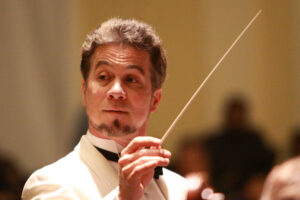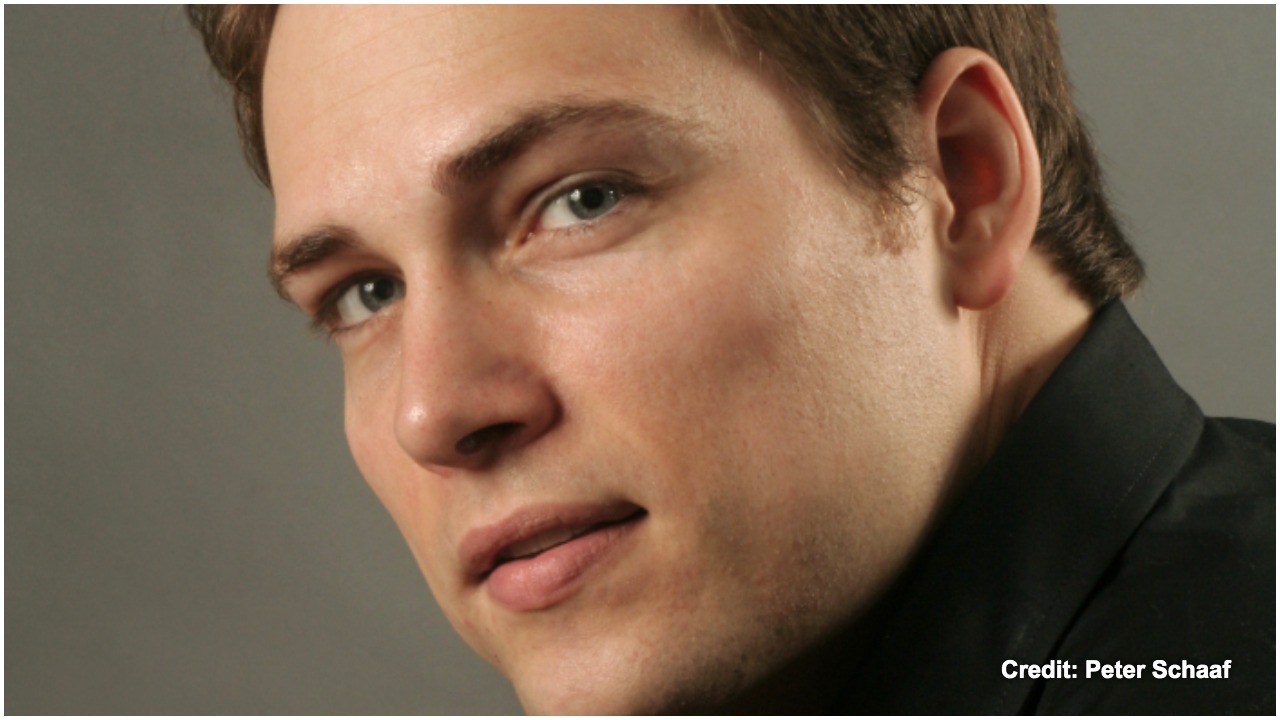
Q & A: Conductor & Arranger Jonathan McPhee on ‘The Essential Ring’
By Chris RuelCredit Frank Caliri
Jonathan McPhee boasts a diverse musical portfolio. As the Music Director for the Lexington Symphony in Massachusetts and a Guest Conductor at the Houston Ballet, his expertise doesn’t stop there — he’s also a composer and arranger. With an affinity for arranging, he’s notably transformed grand pieces, such as Stravinsky’s “Rite of Spring” and “Firebird” into reductions. But as you’ll soon find out, a particular monumental piece, Wagner‘s Ring, has held his attention for many years.
His vision, “The Essential Ring,” is well underway. “Das Rheingold,” and now “Die Walküre,” are published entities. (“Die Walküre” became available this fall.) and he’s moving on to the next half of the cycle.
McPhee has a warm and personable way about him, making things clear and easy to grasp without diving deep into a music theory lesson. This matches up with his drive behind “The Essential Ring;” his aim is to bring the expansive masterpiece closer to audiences and regional opera companies, for whom Wagner’s work might typically be a stretch.
OperaWire spoke with McPhee to gain insights into this exciting project.
OW: Where did the idea of reducing The Ring scores come from?
Jonathan McPhee: It originated 35 years ago, when as a student I saw my first Wagner opera at the Royal Academy at Covent Garden. It was amazing, but really long. When I moved on to Juilliard, my teacher, Sixten Ehrling, was doing Wagner at the Met. I sat in the pit and once again, I thought, “This is really great stuff, but it’s really long.”
I’ve been to performances where the scores were hacked up–the key relationships didn’t work, the story gone, and people wanted to come to just hear the music. This bothered me because the context was missing. Over the years, my gut told me I could keep the story, keep the “must have” passages and distill it, so it’s seamless.
OW: What was your process?
JP: [Heldentenor] Thomas Studebaker was the first person I called. He had been singing at the Met, and at first, he was skeptical. I gave him a rough piano score, and he said to me, “I’m going to tell you right now that the first thing you need to be careful of is when we do these truncated excerpts of things, it’s always disorienting for our ears when they have to land on the next thing. There’s not enough time to get acclimated to the key before you have to come in.” So, he told me, “Be kind.”
OW: As you undertook the project, what was your number one priority?
JP: I wanted to keep the story. I started by shortening the libretto as much as I could. After cutting some parts, I realized some things didn’t fit right. If something didn’t work, I’d find another way to connect the parts, making sure singers entered at the right spots. It felt like putting together a puzzle, going back and forth.
I’m proud that to someone unfamiliar with the original, it would seem like it was always written this way
In the back of my mind, I was also thinking of regional opera companies with limited resources and singers who trained but might never perform these works. The reductions would be a great thing for them, too.
OW: You’ve reduced other works. What makes “The Essential Ring” different?
JP: The key is accessibility without sacrificing integrity. I’ve been approached to reduce Prokofiev’s “Romeo and Juliet” multiple times, but I always said no. His orchestration is so detailed that there’s no room for me to trim it while preserving the piece’s integrity.
Going back to what I said about regional opera companies and accessibility in relation to “The Essential Ring” project, I had to consider the pit. One hundred and twelve people simply won’t fit. So, I had to go back again and think about how I could make the orchestra smaller without losing the sounds that are important.
I ended up with the same number of pit musicians as I did with my reduction of “Rite of Spring,” which was 64—the size of a regional pit. There are two versions of “The Essential Ring” score. One is the original orchestration, which you can see on the video, and the other is the version written for the smaller pit.
OW: What have you learned from this project?
JP: I learned so much about how Wagner’s composition changed. You look at the way he wrote “Das Rheingold,” and it’s pretty remarkable–the overture is astounding today as it was back then.
As I progressed through the four operas, cutting became increasingly challenging because of his evolving compositional abilities. By the time I reached “Götterdämmerung,” the last 20 minutes of music left no room for a single cut. His tight through-composition and modulation meant that any attempt to shorten would be a step backward musically.
To a certain degree, there’s instinct involved. I felt this just as I did when working with “Rite of Spring.” I had knowledge of “Firebird” and “Petrushka.” I also knew the different versions of “Firebird” Stravinsky had done. By the time I got to shortening “Rite of Spring,” I had a feeling for how his orchestration changed and developed. I brought that to my approach to “The Essential Ring.”
It’s like learning a language, specifically English. You start with the rudiments – tenses and so on. From there, you discern what is good English and what isn’t, providing a framework of context. I feel this is what I was studying while trying to understand what Wagner wanted to convey. I delved into how he expressed it musically, and the technical tools he used to piece everything together.
Take something as simple as the anvils. You ask, “Why did he need that number of people? What was he going for balance-wise? If I have to use fewer anvils, what can I do to maximize the impact of that?”
I’ll tell you something else I didn’t fully understand until I started inputting the music: I realized that part of the richness in the instrumentation is because he doesn’t double.
So, for example, in some orchestrations, you might see four bars of the first oboe, which match exactly the same four bars the second flute or the first clarinet is playing. They’ll double that to achieve the sonorities.
Wagner never does that.
He’ll use three notes from the oboe, then two notes from the clarinet, and finally one from the bassoon; he’s constantly crossing the lines between instruments. At first glance, it might seem like he’s doubling, but a closer look shows he isn’t.
OW: So no doubling even in the Overture for “Das Rheingold?”
JP: Nope. That was one of the toughest pieces to reduce for an orchestra. It’s never been done before, and that’s because it needed to have the crossovers. But if you have fewer people to do the crossovers, how do you do it without losing the sonorities?
Those six minutes, I can’t tell you how many weeks it took. I did it again, and again, and again, and finally, I think I nailed it. But it was so hard.
OW: How did the pandemic affect the project?
JP: I have to credit the librarians at the Met for providing me with many lists and even bowings for some things they sent. So, I had all this material, and this was in 2017.
I had talked with Boosey about “The Essential Ring,” and they were like, “this is a really interesting project but…”
Back in the 80s and 90s, you could create pasted parts, where you physically cut things and then taped them together. Nowadays, everything has to be newly engraved, not handwritten because young musicians don’t know how to read handwritten parts anymore. This realization struck me as I used to conduct full-sub auditions, including a sight-reading section. Your first opportunity to play in the ballet is likely going to involve sight-reading “Nutcracker,” “Sleeping Beauty,” or “Swan Lake.”
I always had excerpts I knew you couldn’t get, so it was genuinely sight-reading. That approach lasted for a decade and a half, and then, suddenly, no one could sight-read. I remember having a conversation with my librarian, and I asked, ‘What happened?’ We used the same sight-reading materials for 15 years, and now, nobody can read it. I realized they didn’t read manuscripts anymore.
A lot of opera parts are still in manuscript, so as soon as we digitized the sight-reading thing, the kids started sight-reading again.
So, the pandemic hit me with this opportunity to look at this massive project I had created in parts that would never be acceptable to Boosey. And, I was told I had to do two versions—one with full orchestration, one with reduced. I thought, okay, when am I going to have a pause in my career that I could just sit in front of my computer with Finale and put it all in? So, it was a gift.
OW: Tell me more about working with the original engravings.
JP: Since Wagner was creating new instruments as he was going along, he also kept changing notation. He’d start off with old notation for French horns. Then, in the same opera, he’d switch to new notation, like a horn in F down a fifth, whereas in the old notation it’d be up a fifth from the bass clef.
Then, when you get into Wagner tubas, he’d change his mind because he was developing different ideas about how it should be notated, but nobody went back and straightened it out. Luckily, there are several treatises from brass players who don’t all agree. There are still some disputed sections.
OW: Can you give me an example?
JP: Basically, it has to do with what octave something is supposed to be in. Some brass players swear up and down that this or that section should be up here, not down there. I tried my best to really straighten that out after talking to a lot of people and getting input from people who specialize in Wagner’s notation and usage, solving wrong notes, wrong rhythms, and, of course, the wording. He made up words which made things tricky, too. He was a creative force who created his own world.
There’s a tuba part in the opening of “Die Walküre” that Wagner didn’t write. It was funny, a tuba player was furious with me, saying, “You didn’t know enough to put in the tuba part!” I said, “There is no tuba part.”
Ultimately, I used it because you need the extra oomph at the bottom.
OW: What has been audience response?
JP: In Lexington and when we did it in New Hampshire, they both sold out. We could’ve sold more seats if we had them.
We gained new supporters from both a development standpoint and among audience members who were blown away by the quality of the performance and the singers. It was a boost forward for the organization in so many ways.
OW: Final Thoughts
JP: I wanted to give access to musicians and audiences. When you look at opera houses, they say the top sellers are Wagner and Verdi operas. They’re the most expensive and dangerous to produce. This was just another reason to do “The Essential Ring” and give access to regional companies, so they, too, could perform Wagner.
This is going to get out there. It may take five to ten years to get it into people’s consciousness, but I hope not.
You can watch the Lexington Symphony performing McPhee’s reduction of “Das Rheingold” here.


